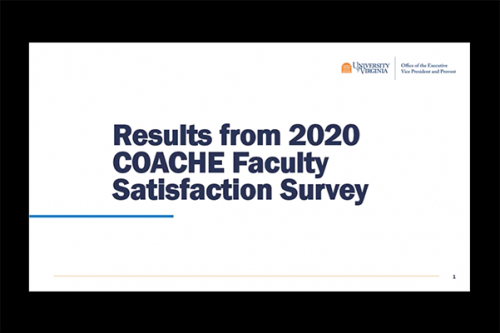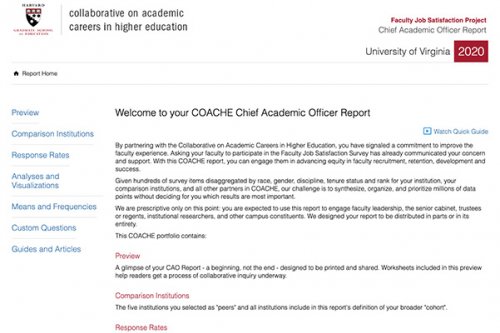Previous COACHE Findings
Highlights from COACHE 2020
Purpose
The Faculty Job Satisfaction Survey provides actionable data about the conditions–the environment, policies and practices–that support faculty doing their best work. Find out more about survey topics and format on the COACHE website.
COACHE 2020 Demographics
All full-time salaried teaching & research faculty (tenured, tenure-track & General) who have worked at UVA for at least one year, except for the School of Medicine as well as senior academic administrators (deans & assoc. deans).
- Response rate in 2020: 38% (Peers 38%)
-
Quality of Colleagues
-
Quality of Undergraduates
-
Support of Colleagues
-
Geographic Location
-
Academic Freedom
-
Compensation
-
Lack of Diversity
-
Too Much Service
-
Lack of Support for Research/Creative Work
| Issue | Action Taken |
|---|---|
| Compensation |
|
| Lack of Diversity |
|
| Too Much Service |
|
| Lack of Support for Research/Creative Work |
|
Perceived Strengths and Weaknesses
-
Nature of Work: Teaching and Research
-
Facilities and Work Resources
-
Senior Leadership
-
Governance
-
Departmental Quality
-
Nature of Work: Service
-
Personal and Family Policies
-
Mentoring
| Issue | Action Taken |
|---|---|
| Nature of Work: Service |
|
| Personal and Family Policies |
|
| Mentoring |
|

This presentation features an explanation of the survey and key findings, narrated by Vice Provost for Faculty Affairs Maïté Brandt-Pearce. The presentation is captioned. A PDF of the slides is also available.

The COACHE 2020 report will launch in another tab and you will leave the provost’s website. Netbadge login is required.
Contact Maïté Brandt-Pearce if you need this information in an accessible format.
Background
UVA has administered the COACHE Faculty Job Satisfaction Survey every three to four years since its inception. Knowing our results allows us to gauge the areas where we are improving and where the institution needs to devote attention. This page summarizes the findings and institutional response to the survey conducted in 2016.
COACHE 2016 Demographics:
All full-time salaried teaching & research faculty (tenured, tenure-track & General) who have worked at UVA for at least one year, except for the School of Medicine as well as senior academic administrators (deans & assoc. deans).
Response rate in 2016: 47%
What did Faculty Tell us Were the Best and Worst Aspects of Working at UVA?
Best Aspects of Working at UVA
- Quality of Colleagues
- Quality of Undergraduates
- Geographic Location
- Quality of Graduate Students
Worst Aspects of Working at UVA
- Compensation
- Protections from Service
- Support for Research/Creative Work
- Diversity
What Qualities Were Ranked in the Top and Bottom Third for UVA
Top Third
- Environment for teaching
- Collegiality
- Departmental Leadership (LAM)
- Divisional Leadership (new deans)
We consider those competitive advantages.
Bottom Third
- Facilities conducive to interdisciplinary work
- And 3. Support for obtaining grants (pre- and post-award)
- Quality of graduate students to support research
How Did UVA Respond?
UVA committed to communicating COACHE results to school leadership and the UVA faculty community, as well as undertaking specific centralized initiatives in addition to school-based actions. These centralized initiatives including dedicated funding for various projects through the Strategic Investment Fund (SIF), as well as:
-
Investment in salaries: BOV commitment to 20th position in AAU
-
Investment in faculty: Cluster hires, ToPs hires, pan-university institutes, hiring diverse and interdisciplinary new faculty
-
Investment in infrastructure:
-
Support for obtaining grants (pre- and post-award) through ResearchUVA, ResearchNet, and 3Cavaliers
-
Pan-University Institutes
-
$22 million in SIF funding for various project infrastructure needs, including facilities conducive to interdisciplinary work, such as the Link Lab
-
School of Data Science; plans for the Ivy corridor and the precincts there
-
-
Investment in graduate programs: A&S and SEAS graduate programs’ SIF grants; development of “PhD Plus” program
Contact Maïté Brandt-Pearce if you need this information in an accessible format.
 Provost
Provost